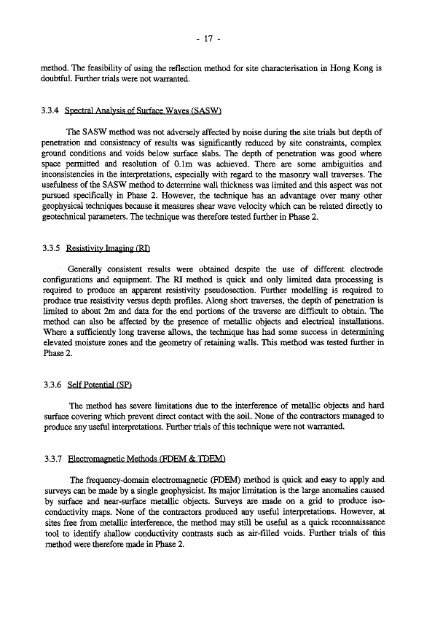site characterisation study - phases 1 and 2 - HKU Libraries - The ...
site characterisation study - phases 1 and 2 - HKU Libraries - The ...
site characterisation study - phases 1 and 2 - HKU Libraries - The ...
- No tags were found...
Create successful ePaper yourself
Turn your PDF publications into a flip-book with our unique Google optimized e-Paper software.
- 17 -method. <strong>The</strong> feasibility of using the reflection method for <strong>site</strong> <strong>characterisation</strong> in Hong Kong isdoubtful Further trials were not warranted.33.4 Spectral Analysis of Surface Waves (SASW)<strong>The</strong> SASW method was not adversely affected by noise during the <strong>site</strong> trials but depth ofpenetration <strong>and</strong> consistency of results was significantly reduced by <strong>site</strong> constraints, complexground conditions <strong>and</strong> voids below surface slabs. <strong>The</strong> depth of penetration was good wherespace permitted <strong>and</strong> resolution of 0.1m was achieved. <strong>The</strong>re are some ambiguities <strong>and</strong>inconsistencies in the interpretations, especially with regard to the masonry wall traverses. <strong>The</strong>usefiilness of the S ASW method to determine wall thickness was limited <strong>and</strong> this aspect was notpursued specifically in Phase 2. However, the technique has an advantage over many othergeophysical techniques because it measures shear wave velocity which can be related directly togeotechnical parameters. <strong>The</strong> technique was therefore tested further in Phase 2.3.3.5 Resistivity Imaging (RT)Generally consistent results were obtained despite the use of different electrodeconfigurations <strong>and</strong> equipment. <strong>The</strong> RI method is quick <strong>and</strong> only limited data processing isrequired to produce an apparent resistivity pseudosection. Further modelling is required toproduce true resistivity versus depth profiles. Along short traverses, the depth of penetration islimited to about 2m <strong>and</strong> data for the end portions of the traverse are difficult to obtain. <strong>The</strong>method can also be affected by the presence of metallic objects <strong>and</strong> electrical installations.Where a sufficiently long traverse allows, the technique has had some success in determiningelevated moisture zones <strong>and</strong> the geometry of retaining walls. This method was tested further inPhase 2.3.3.6 Self Potential (SP)<strong>The</strong> method has severe limitations due to the interference of metallic objects <strong>and</strong> hardsurface covering which prevent direct contact with the soil. None of the contractors managed toproduce any useful interpretations. Further trials of this technique were not warranted.3.3.7 Electromagnetic Methods (FDEM & TDEM)<strong>The</strong> frequency-domain electromagnetic (FDEM) method is quick <strong>and</strong> easy to apply <strong>and</strong>surveys can be made by a single geophysicist Its major limitation is the large anomalies causedby surface <strong>and</strong> near-surface metallic objects. Surveys are made on a grid to produce isoconductivitymaps. None of the contractors produced any useful interpretations. However, at<strong>site</strong>s free from metallic interference, the method may still be useful as a quick reconnaissancetool to identify shallow conductivity contrasts such as air-filled voids. Further trials of thismethod were therefore made in Phase 2.
















